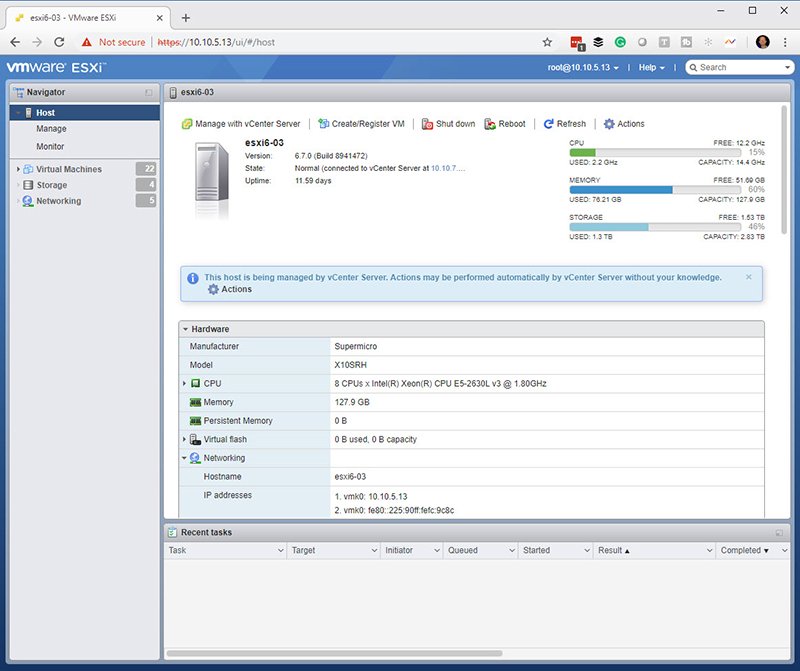VMware ESXi-a tech definition
Reading Time-approximately: 3 minutesVMware ESXi is an operating system-independent hypervisor based on the VMkernel operating system that interfaces with agents that run on top of it. ESXi stands for Elastic Sky X Integrated.
ESXi is a type-1 hypervisor, meaning it runs directly on system hardware without the need for an operating system (OS). Type-1 hypervisors are also referred to as bare-metal hypervisors because they run directly on hardware.
ESXi is targeted at enterprise organizations. VMware describes an ESXi system as similar to a stateless compute node. Virtualization administrators can upload state information from a saved configuration file.
ESXi’s VMkernel interfaces directly with VMware agents and approved third-party modules. Admins can configure VMware ESXi using its console or a vSphere client. They can also check VMware’s hardware compatibility list for approved, supported hardware on which to install ESXi.
Different versions of ESX and ESXi
VMware released ESXi after the release of VMware ESX version 4.1 in 2010. After version 5 of ESX, only ESXi has continued support. ESXi is currently on version 6.7, which mainly includes bug fixes for previous ESXi versions.
ESX licensees can choose to deploy ESXi instead of ESX on any given server. Before ESXi, VMware offered the ESX hypervisor, which comprised more parts, such as the console OS and firewall. Remote command-line interfaces and system management standards replaced the service console functions.
The hypervisor supports Auto Deploy and custom image creation, along with other tools that weren’t included in ESX. According to VMware, ESXi’s architecture occupies less than 150 MB of space — 32 MB of on-disk space — compared to about 2 GB with ESX.
A stripped-down, free version of ESXi — VMware vSphere Hypervisor — supports fewer features. Although it can’t communicate with vCenter Server, it virtualizes servers with options like thin provisioning. The paid version of ESXi includes live migration of machines, automatic load balancing, and pooling storage and compute resources across multiple hosts.
ESXi requirements and setup
As ESXi is lightweight, it requires a minimum amount of hardware resources. Specifically, ESXi version 6.7 requires a host machine with a minimum of 2 two CPU cores, a 64-bit x86 processor released before 2006, and 4 — or, preferably, 8 — GB of RAM. Admins can find a full list of the required resources for ESXi 6.7 under Hardware and System Resources in VMware’s ESXi Installation and Setup Guide.
ESXi is installed directly on a local hard disk in the host machine. To install ESXi, start the installer and simply follow the prompts. After ESXi is installed, admins can use the direct console to change the ESXi host options, such as assigning IP addresses or other configuration options. They can then install vSphere Web Client or vSphere Client, which both help launch virtual machines (VMs).
Finally, when admins gain access to the host machine and their vSphere client of choice, they can launch a VM. Admins should keep in mind that with the next vSphere update — following vSphere 6.7 update 1 — the Web Client will be depreciated.
Key features of ESXi
VMware ESXi supports key features including traffic shaping, memory ballooning, role-based security access, logging and auditing, a GUI, and vSphere PowerCLI. ESXi also has the ability to configure 128 CPUs and 120 devices.

Admins can manage this functionality using remote tools instead of a CLI, and ESXI can use an API-based integration model instead of third-party management agents. ESXi supports the creation of VMs with VMware Server and Microsoft Virtual Server.
ESXi benefits and drawbacks
Installing ESXi in a data center is quick and simple because of its lightweight footprint of 150 MB. Also, admins need fewer patches because of ESXi’s lightweight format. Due to its smaller size, ESXi is seen as more secure. In addition, security management is built into the VMkernel. ESXi also offers a simplified GUI.
Unfortunately, ESXi offers fewer configuration options to maintain its size. There is also a learning curve for those who haven’t used a virtualization product before.
Another drawback to ESXi is that the overhead created with additional CPU work and OS calls might cause an application to slow down in a VM. The free version of ESXi also limits users to the use of two physical CPUs.
VMware ESXi and vSphere
VMware vSphere acts as a suite of VMware’s server virtualization products, which includes ESXi. ESXi is the exclusive hypervisor for VMware vSphere 5.x licenses. Admins can use a vSphere host as a foundation for a private cloud environment.
VMware products included in vSphere encompass software such as VMware vCenter Server, vSphere Web Client, vSphere Client, vSphere Distributed Switch, VMware High Availability and VMware Virtual Symmetric Multi-Processing.
VMware ESXi vs. XenServer
Citrix XenServer is an open source server virtualization platform comparable to ESXi that is based on the Xen hypervisor. Xen is also a type-1 hypervisor; however, XenServer is aimed at consumers. XenServer can host, deploy and manage server desktop and cloud VMs.
Margaret Rouse asks:
What VMware ESXi feature do you find most useful when managing your virtual environment?
Join the Discussion
Features in XenServer include live VM migration, health checks and performance reporting alerts. Xen is included in the Linux kernel; however, it’s only supported by a small number of Linux distributions, such as SUSE Linux Enterprise Server.


